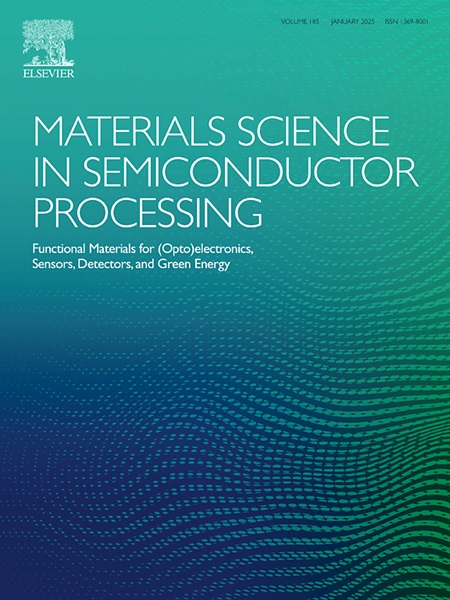Improving the efficiency of CIGSSe solar cells by forming electrically beneficial ordered vacancy compound layers under a suitable H2/(Ar+H2) atmosphere
IF 4.6
3区 工程技术
Q2 ENGINEERING, ELECTRICAL & ELECTRONIC
引用次数: 0
Abstract
High-efficiency Cu(In,Ga)(S,Se)2 (CIGSSe) thin-film solar cells have been successfully fabricated using a sulfurization after selenization (SAS) process for the CuGa/In stacks. However, the sulfur-rich front surface of the CIGSSe absorber led to an upshifted conduction-band minimum and formed an undesired cliff-type band alignment. A Cu-poor ordered vacancy compound (OVC) layer on the CIGSSe surface was beneficial for forming a spike-type band alignment with CIGSSe, thus reducing recombination losses. In this study, a superior buried homojunction at the CIGSSe/cadmium sulfide (CdS) interface was successfully obtained because of the formation of a wide bandgap and smooth OVC layer when the In layer was sputtered on top of the CuGa bottom layer in Ar and H2 atmospheres. Additionally, the surface roughness, grain size, and crystallinity of the CIGSSe absorber improved. The highest efficiency of 14.78 % for the CIGSSe solar cell (without an antireflective coating and thinner CdS) was achieved using 0.2 % H2/(Ar + H2) for In-layer sputtering. These results demonstrate that the efficiency of the CIGSSe solar cells can be improved by forming an electrically beneficial OVC layer under a suitable H2/(Ar + H2) atmosphere.
在合适的H2/(Ar+H2)气氛下形成有利于电的有序空位化合物层,提高CIGSSe太阳能电池的效率
采用硒化后硫化(SAS)工艺成功制备了Cu(In,Ga)(S,Se)2 (CIGSSe)薄膜太阳能电池。然而,CIGSSe吸收体的富硫前表面导致了一个上移的导带最小值,并形成了一个不希望的悬崖型带对准。在CIGSSe表面形成缺cu有序空位化合物(OVC)层有利于与CIGSSe形成尖峰型带对准,从而减少复合损失。本研究在Ar和H2气氛下,将In层溅射到CuGa底层上,形成了宽带隙和光滑的OVC层,从而成功地在CIGSSe/硫化镉(CdS)界面上获得了优越的埋藏均匀结。此外,吸收剂的表面粗糙度、晶粒尺寸和结晶度都得到了改善。使用0.2% H2/(Ar + H2)进行层内溅射时,CIGSSe太阳能电池的最高效率为14.78%(没有抗反射涂层和更薄的CdS)。这些结果表明,在合适的H2/(Ar + H2)气氛下形成有利于电的OVC层可以提高CIGSSe太阳能电池的效率。
本文章由计算机程序翻译,如有差异,请以英文原文为准。
求助全文
约1分钟内获得全文
求助全文
来源期刊

Materials Science in Semiconductor Processing
工程技术-材料科学:综合
CiteScore
8.00
自引率
4.90%
发文量
780
审稿时长
42 days
期刊介绍:
Materials Science in Semiconductor Processing provides a unique forum for the discussion of novel processing, applications and theoretical studies of functional materials and devices for (opto)electronics, sensors, detectors, biotechnology and green energy.
Each issue will aim to provide a snapshot of current insights, new achievements, breakthroughs and future trends in such diverse fields as microelectronics, energy conversion and storage, communications, biotechnology, (photo)catalysis, nano- and thin-film technology, hybrid and composite materials, chemical processing, vapor-phase deposition, device fabrication, and modelling, which are the backbone of advanced semiconductor processing and applications.
Coverage will include: advanced lithography for submicron devices; etching and related topics; ion implantation; damage evolution and related issues; plasma and thermal CVD; rapid thermal processing; advanced metallization and interconnect schemes; thin dielectric layers, oxidation; sol-gel processing; chemical bath and (electro)chemical deposition; compound semiconductor processing; new non-oxide materials and their applications; (macro)molecular and hybrid materials; molecular dynamics, ab-initio methods, Monte Carlo, etc.; new materials and processes for discrete and integrated circuits; magnetic materials and spintronics; heterostructures and quantum devices; engineering of the electrical and optical properties of semiconductors; crystal growth mechanisms; reliability, defect density, intrinsic impurities and defects.
 求助内容:
求助内容: 应助结果提醒方式:
应助结果提醒方式:


